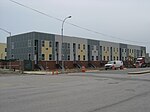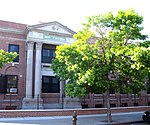Gateway Center (Brooklyn)
2002 establishments in New York CityCommercial buildings in BrooklynEast New York, BrooklynShopping malls established in 2002Shopping malls in New York City ... and 2 more
Tourist attractions in BrooklynUse mdy dates from May 2019

Gateway Center, also referred to as Gateway Plaza Mall or simply Gateway Mall, is a shopping complex in the Spring Creek section of East New York, Brooklyn, in New York City. It is located just north of the Belt Parkway at Erskine Street and Gateway Drive, which is near portions of the Gateway National Recreation Area. Built as part of the Gateway Estates plan for commercial and retail development, it consists of two structures: the original structure opened in 2002 (now called Gateway Center South), and a second adjacent development opened in 2014 (called Gateway Center North or Gateway Center II).
Excerpt from the Wikipedia article Gateway Center (Brooklyn) (License: CC BY-SA 3.0, Authors, Images).Gateway Center (Brooklyn)
Belt Parkway, New York Brooklyn
Geographical coordinates (GPS) Address Nearby Places Show on map
Geographical coordinates (GPS)
| Latitude | Longitude |
|---|---|
| N 40.651943 ° | E -73.870592 ° |
Address
Belt Parkway
11239 New York, Brooklyn
New York, United States
Open on Google Maps










